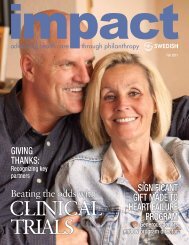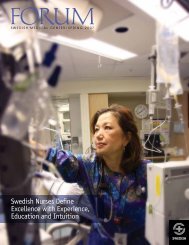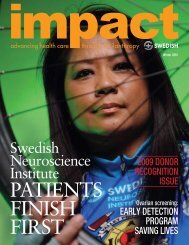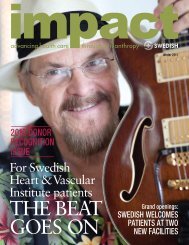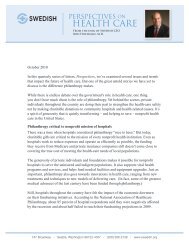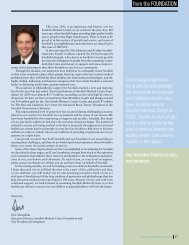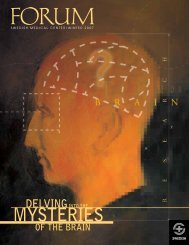PATIENTS FINISH FIRST - Swedish Medical Center Foundation
PATIENTS FINISH FIRST - Swedish Medical Center Foundation
PATIENTS FINISH FIRST - Swedish Medical Center Foundation
You also want an ePaper? Increase the reach of your titles
YUMPU automatically turns print PDFs into web optimized ePapers that Google loves.
FEATURE<br />
<strong>Swedish</strong><br />
TELESTROKE PROGRAM<br />
T<br />
he day before Thanksgiving 2009 began<br />
as an ordinary one for James Howard,<br />
a 56-year-old resident of Wenatchee,<br />
Washington. But in the early afternoon,<br />
while he was in the shower, the unexpected<br />
happened: First Howard felt his<br />
face begin to tingle, followed by a numb<br />
sensation in his left arm and leg and a<br />
feeling of weakness. Alarmed, Howard<br />
rushed out of the shower and asked his<br />
wife, Carla, to take him to the emergency<br />
room at Wenatchee’s Central Washington<br />
Hospital.<br />
“At first I didn’t know what the symptoms<br />
were, but when my arm and leg<br />
went numb on the left side, I figured out<br />
I was probably having a stroke,” recalls<br />
Howard.<br />
Scott Stroming, M.D., the attending ER<br />
physician at Central Washington Hospital,<br />
evaluated Howard and, after ascertaining<br />
a stroke was in progress and potentially<br />
reversible, made a crucial decision:<br />
Consult the stroke experts at <strong>Swedish</strong><br />
<strong>Medical</strong> <strong>Center</strong>’s Neuroscience Institute<br />
(SNI). Many hospitals may not have a<br />
stroke specialist on staff or available during<br />
time-critical situations. Videoconferencing<br />
technology enables the <strong>Swedish</strong><br />
team to provide immediate diagnosis<br />
and treatment suggestions to physicians<br />
caring for such patients. In this case,<br />
immediate access to specialty care was<br />
available because Central Washington<br />
Hospital is one of a growing number of<br />
institutions participating in SNI’s Acute<br />
Stroke Telemedicine Program, which<br />
connects <strong>Swedish</strong> physicians with facilities<br />
in outlying areas of the Northwest<br />
through a live, secure videoconferencing<br />
connection, augmented by high bandwidth<br />
computer connections that also<br />
permit the <strong>Swedish</strong> physician to review<br />
the brain images to further assist in the<br />
diagnosis.<br />
In the case of stroke — which affects<br />
approximately 700,000<br />
Americans a year and is the<br />
leading cause of adult disability<br />
in the United States<br />
— immediate consultation<br />
with a stroke expert can<br />
significantly improve a patient’s<br />
functional outcome.<br />
Stroke experts, such as the<br />
team at <strong>Swedish</strong>, work with<br />
referring physicians collaboratively<br />
to provide a “rescue<br />
treatment,” a drug called<br />
alteplase (or a “clot-buster”<br />
drug). Alteplase can improve<br />
a stroke patient’s recovery by<br />
30 percent — but only if it is<br />
administered within the first<br />
4.5 hours after a stroke occurs.<br />
James Howard was one<br />
of the lucky ones: Dr. Stroming,<br />
in consultation with<br />
members of <strong>Swedish</strong>’s Acute<br />
Telestroke Team — William Likosky, M.D.<br />
(medical director of the <strong>Swedish</strong> Stroke/<br />
Telestroke programs), and Michael<br />
Fruin, ARNP — decided that Howard<br />
was a good candidate for this drug treatment,<br />
and he is expected to make a full<br />
recovery. Without treatment, many persons<br />
in a similar situation may have<br />
long-term neurological problems such as<br />
weakness, paralysis or speech problems,<br />
which may prevent them from working<br />
or living independently.<br />
“I had no idea this resource was available<br />
in Washington state,” says Howard.<br />
“In years past, I probably would have been<br />
transferred to a hospital across the state,<br />
and it might have been too late.” But now,<br />
stroke patients can use technology to get<br />
help from an expert during the 4.5-hour<br />
treatment window.<br />
The idea for expanding the <strong>Swedish</strong><br />
Stroke Program into a Telestroke Program<br />
dates to 2004, when <strong>Swedish</strong><br />
held a patient-education seminar<br />
on the emerging field of<br />
comprehensive stroke care.<br />
“This seminar included discussions<br />
about why a stroke patient<br />
needs to know the symptoms of a<br />
stroke and subsequently needs to<br />
get to an emergency room which<br />
has the capability to offer this<br />
treatment, as soon as they recognize<br />
the symptoms,” says Sherene<br />
Schlegel, RN, <strong>Swedish</strong> manager<br />
of Stroke/Telestroke programs,<br />
adding that all four <strong>Swedish</strong> campuses<br />
— First Hill, Cherry Hill,<br />
Ballard and Issaquah — are certified<br />
as Primary Stroke <strong>Center</strong>s by<br />
the Joint Commission. “At one point, a<br />
resident of one of Washington’s islands<br />
asked what her options were since she<br />
didn’t have ready access to such an ER.<br />
We didn’t have an answer for her at the<br />
time, but we were poised to respond<br />
when we were exposed to the telestroke<br />
program at Massachusetts General Hospital<br />
in 2006.”<br />
In search of solutions for patients in<br />
outlying areas, in 2006 <strong>Swedish</strong> signed<br />
a partnership agreement with Massachusetts<br />
General, a pioneer and national<br />
leader in the use of stroke telemedicine.<br />
With the generous support of the philanthropic<br />
community, <strong>Swedish</strong> committed<br />
to learning best practices from Massachusetts<br />
General and launched its Acute Telestroke<br />
Program, the first in this region.<br />
“Massachusetts General had a lot of<br />
expertise to share with <strong>Swedish</strong>. They advised<br />
us on the ways to execute telemedicine,<br />
including the infrastructure, processes<br />
and technology involved, allowing<br />
us to develop a unique program for our<br />
region,” says Tammy Cress, RN, <strong>Swedish</strong><br />
director of Telehealth. Cress adds that the<br />
program has also received major support<br />
from <strong>Swedish</strong>’s Information Systems, Infor-<br />
Through a two-way videoconferencing link, <strong>Swedish</strong> is able to provide<br />
real-time assessment of patients at outlying hospitals. Here, a <strong>Swedish</strong><br />
stroke specialist performs a “virtual” bedside neurological evaluation<br />
in collaboration with ER staff at a partner hospital.<br />
mation Technology and Radiology departments,<br />
as well as from GCI ConnectMD,<br />
an Alaska-based company that provides<br />
health-care organizations with connectivity<br />
and communication tools for exchanging<br />
information.<br />
Currently, <strong>Swedish</strong>’s stroke telemedicine<br />
program is operating at the hospital’s<br />
Issaquah and Ballard campus ERs<br />
and at four additional Washington hospitals:<br />
Central Washington Hospital in<br />
Wenatchee, Skagit Valley Hospital in<br />
Mount Vernon, Jefferson Healthcare in<br />
Port Townsend and Lake Chelan Community<br />
Hospital in Chelan. “Our relationship<br />
with these hospitals is to be<br />
on-call round the clock and to provide<br />
telemedicine support for patients who<br />
come into their emergency rooms with<br />
acute stroke symptoms. We also provide<br />
telephone support to them on stroke<br />
cases in which they wish to discuss<br />
medical management, specifically sorting<br />
through whether select cases would<br />
benefit from transfer to <strong>Swedish</strong> for specialty<br />
care,” says Cress.<br />
Dr. William Likosky says his team is<br />
eager to share its expertise beyond the<br />
walls of its own hospital for the benefit<br />
of patients in other communities.<br />
“<strong>Swedish</strong> has invested a great deal<br />
to build a distinguished stroke<br />
center, and we have a well-trained<br />
and caring group of people,” says<br />
Dr. Likosky. “Studies have demonstrated<br />
that you can evaluate an<br />
acute stroke patient via teleconferencing<br />
virtually as well as being<br />
there. The participating ER doctors<br />
are receptive to the advice and<br />
insight offered by our providers.<br />
We play a consultative role.”<br />
According to Dr. Likosky, telemedicine<br />
programs like the one at<br />
<strong>Swedish</strong> are crucial if doctors are<br />
to provide timely and comprehensive<br />
care to patients when time is of the<br />
essence, or when travel may not be possible.<br />
“Physicians in specialties which<br />
are not well represented throughout our<br />
region are now able to extend their care<br />
to patients in outlying facilities. The<br />
benefits into the future are enormous as<br />
we create a Washington community in<br />
which expectations for sophisticated<br />
treatments become a reality irrespective<br />
of where one chooses to live.”<br />
“The technology is complex, but with<br />
the collaboration with experts in Information<br />
Technology, we are able to provide<br />
access to advanced technological platforms<br />
enabling physicians to provide<br />
appropriate advice to facilitate treatments,”<br />
says Jamile Mack, SNI senior program<br />
manager/technology.<br />
This groundbreaking program continues<br />
to grow as <strong>Swedish</strong> speaks to other<br />
hospitals in the region that are interested<br />
in partnering in telemedicine relationships<br />
to bring specialty care that otherwise might<br />
not be available to their communities,<br />
says Cress. i<br />
Jennifer Schaefer is a Seattle-based<br />
writer and editor. She can be reached at<br />
schaefer.jen@gmail.com.<br />
12 IMPACT WINTER 2010 www.swedishfoundation.org 13



